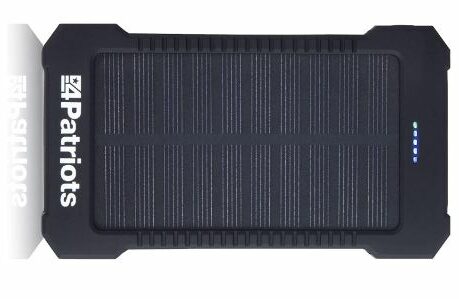The Patriot Power Cell is a solar powered phone charger made by 4Patriots. If you’ve never heard about them, 4Patriots is a company that sells survival and outdoor gear including survival food kits, solar lanterns and flashlights, and portable power stations.
The Patriot Power Cell is one of their most popular products. It is essentially an 8,000 mAh power bank with a built-in solar panel. It’s designed for hiking, camping, traveling and emergencies.
In this review, I take a detailed look at the Patriot Power Cell, what it can do, and its limitations. I also include three alternatives if you feel the Patriot Power Cell is not for you.
You can also read my reviews of the best solar powered phone chargers for additional alternatives.
Patriot Power Cell Pros & Cons
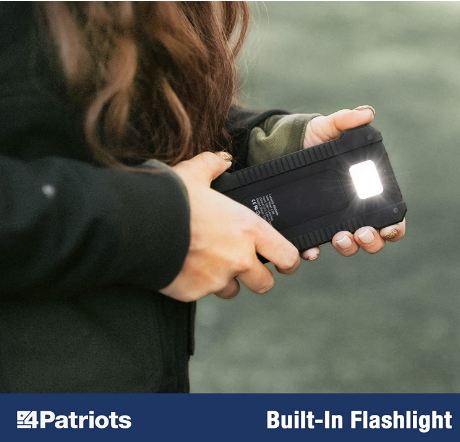
Pros
Cons
Best Features
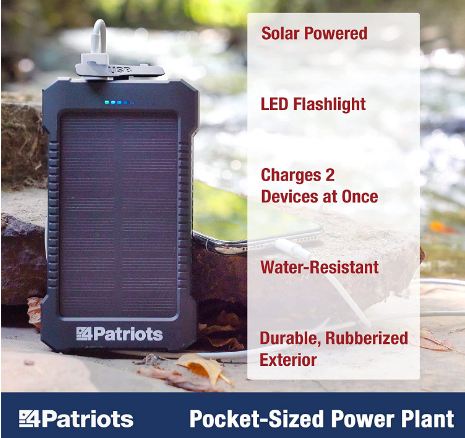
8,000 mAh Lithium Polymer Battery
Let’s start with the size of the Patriot Power Cell. As power banks go, the Patriot Power Cell is not very big.
As I explain in the limitations section further below, 8000 mAh is not a ton of power for most modern smartphones. And if you want to charge multiple phones or devices, you’ll find the capacity to be very limiting.
That said, the 8,000 mAh battery in the Patriot Power Cell is enough to charge most phones and tablets 1-3 times.
If you are shopping for a power bank for use on day trips and hikes or plane/train travel, then the Patriot Power Cell is probably adequate for your needs.
It can keep your phone charged for a day.
Note: The lithium battery in the Patriot Power Cell is TSA-approved, so you can take the power bank with you on a plane.
Two USB-A Ports
The Patriot Power Cell has two built-in USB-A ports, so you can charge two phones or devices at the same time.
These are regular 5V/2.1A ports, so don't expect any fast charging.
With the USB ports, you can charge or power just about any small device or gadget that uses a USB cable including cameras, bluetooth speakers, portable lights, Kindle, personal fan or humidifier and so on.
Two Ways To Recharge
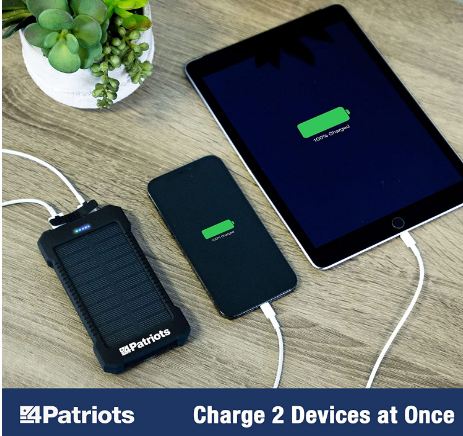
You can recharge the Patriot Power Cell either through the integrated solar panel or the USB port.
Let me save you the trouble: don't bother using the solar panel unless it’s an emergency. As many customers note in their reviews, the 5 inch solar panel is pretty much pointless.
It takes 40 hours or about 4 days for the solar panel to fully recharge the power bank. And that’s assuming you don't plug in your phone until the battery is fully charged.
Stick to USB charging. But even that takes quite a bit of time - 6 hours. But at least you don't have to wait for days for the battery to recharge, and you can charge it at any time even at night.
Where the solar panel might be useful is when you are outdoor hiking or camping. You can place the power bank on the ground, hang it from the tent, or attach it to your backpack to top it up with the sun.
But even a full day of hiking with the Patriot Power Cell on your back doesn't add much to the batteries.
Small & Lightweight
Like other portable solar phone chargers, the Patriot Power Cell is easy to travel with. It’s small enough to fit in a bag or backpack and it only weighs 6.8 ounces (0.4lbs).
Unlike portable power stations, you can take the Patriot Power Cell with you when hiking or backpacking.
Rugged Design
The Patriot Power Cell is designed to withstand the rough outdoors. It has a rubberized exterior to protect it from falls and hits.
It also has IP67 protection, meaning it can withstand water splashes, rain and dust. If you are out hiking and get caught in a storm, the Patriot Power Cell will be fine.
Issues & Limitations
Limited Capacity
Let’s get back to the capacity issue. 8000 mAh may seem like a lot, but a majority of modern phones have a capacity of at least 4,000 mAh.
That means the Patriot Power Cell can only charge a 4,000 mAh phone twice. Keep in mind that you may not be able to access the entire 8000 mAh capacity. Batteries retain some charge to prevent permanent damage.
If you are going camping for a couple of days or you experience a blackout lasting a few days, the Patriot Power Cell will probably not be enough.
The Patriot Power Cell is also inadequate if you often travel with multiple devices like a camera, drone, bluetooth speaker, tablet, and phone.
If you want a solar phone charger or power bank that can keep your phone charged for more than a day or charge multiple devices, I recommend getting one with a minimum 15000 mAh capacity. 20000 mAh is even better.
Slow Charging
I’ve already talked about the solar panel issue. It looks like a useful addition, but the built-in solar panel is just a gimmick. It takes forever to recharge the battery.
The USB option is faster but still slow compared to other power banks.
This problem is not unique to the Patriot Power Cell. Many power banks with a built-in solar panel don't really offer useful solar charging. The best alternative is to get a foldable portable solar panel (like the BigBlue 28W solar panel I have reviewed below) and pair it with a regular power bank.
No USB-C or Quick Charge Port
USB-C is quickly becoming the standard on phones and other devices. So it is a major limitation that the Patriot Power Cell doesn't have a USB-C port.
Not only would it allow easy compatibility with modern phones, but USB-C charging is also quicker. As it is, you’ll need a USB-A to USB-C charging cable.
At the very least, 4Patriots should have added a QC USB-A port for faster charging.
Not The Best Value For Money
Overall, I don’t think the Patriot Power Cell is the best bargain around. It’s not too pricey, but you can get higher capacity solar phone chargers with additional features for that price.
I recommend shopping around more before settling on the Patriot Power Cell.
Patriot Power Cell Reviews: What Do Customers Say?
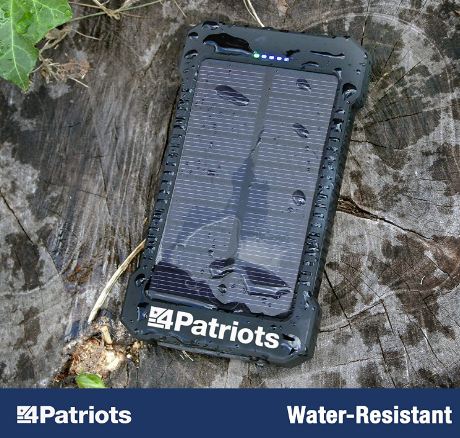
The Patriot Power Cell may not be the best solar power bank you can get, but it’s well made and it works just as well as most other power banks.
It’s not surprising that it has high ratings on Amazon. Currently, it has 4.3 stars from almost 2,000 reviews.
The biggest complaint from customers is about solar charging. In their advertising, Patriot Power Cell seems to oversell the performance of the built-in solar panel.
In reality, it’s a little more than a shiny gimmick. At least the company warns in the manual that the solar charger is for emergency use only.
Several customers also mention the limited capacity. Many say they are only able to charge their phone 2 times before the power bank goes empty.
Generally, many users love their Patriot Power Cell. It’s easy to travel with, it keeps their phone charged for a day, and it feels durable.
Best Alternatives To The Patriot Power Cell
Not a fan of the Patriot Power Cell? Here are three alternatives to consider.
1. Blavor Solar Charger with Foldable Panels - Higher Capacity
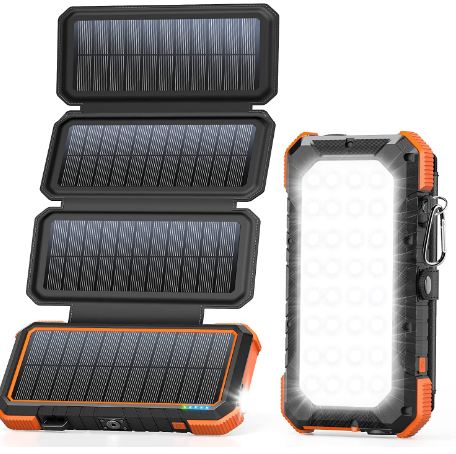
The Blavor 20000 mAh charger will be more useful for most people. On a full charge, the Blavor power bank can recharge most smartphones 3-6 times.
Instead of a small built-in solar panel, the Blavor charger comes with separate foldable panels. They are very light and you can hang them off your backpack when hiking.
The foldable panels have a wider surface area and thus collect more power than the panel on the Patriot Power Cell. That said, they still struggle to recharge the 20,000 mAh battery in the Blavor solar charger.
They are not completely useless, but I recommend using solar charging only in an emergency or to top up the power bank when you are outdoors.
It’s way faster to recharge the power bank via the micro USB or USB-C input ports.
The Blavor solar charger also has more and better charging ports than the Patriot Power Cell. You get three USB ports.
These include a regular 5V/3A USB-A port, a Quick Charge 18W USB-A port, and an 18W USB-C PD port (which you can also use to recharge the power bank).
So not only does the Blavor 20000 mAh power bank support more devices, it charges them faster, too. Most smartphones are able to recharge in under two hours through the QC USB-A port or the USB-C port.
The Blavor solar charger is great for outdoor activities like hiking and camping. It’s lightweight, shockproof and waterproof, comes with a carabiner for hanging, and you also get built-in lights (an emergency flashlight and bright camping light).
2. BigBlue 28W Solar Charger - Best For Solar Charging
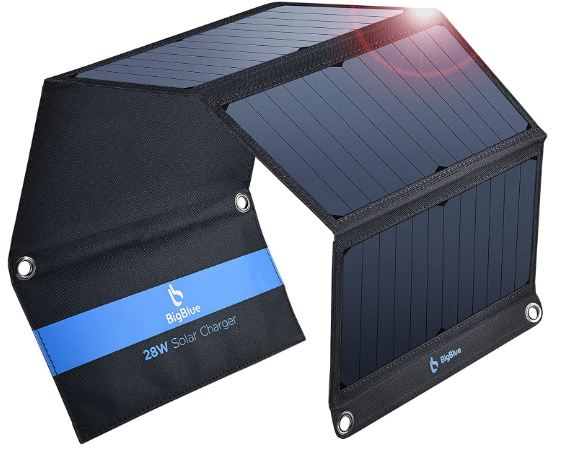
The problem with a lot of solar phone chargers is that they are not really solar chargers. The solar function is usually pointless since it is so slow.
If you want a solar charger that actually charges your phone or power bank with the sun, I recommend the BigBlue 28W solar charger.
This one doesn't come with a power bank, so it doesn't store any of the energy it captures from the sun. It’s just a foldable solar panel.
But it has three 5V/2.4A USB-A ports, so it can directly charge a smartphone or any device. But the best way to use it is to charge a power bank. You can then use the power bank to charge your phone at any time of the day or night.
The BigBlue 28W solar charger is miles better than the small solar panels included with some power banks. Many customers say they can charge their 20,000 to 30,000 mAh power bank to 100% in a day using the BigBlue solar charger.
If you connect your phone directly to the solar panel, it’ll charge it in a few hours as long as it’s sufficiently sunny.
The BigBlue solar panel weighs 20.5 ounces (1.2lbs), so you can carry it along with a power bank on backpacking and hiking trips. It’s also great for camping.
3. Jackery Explorer 160 - Best Portable Power Station
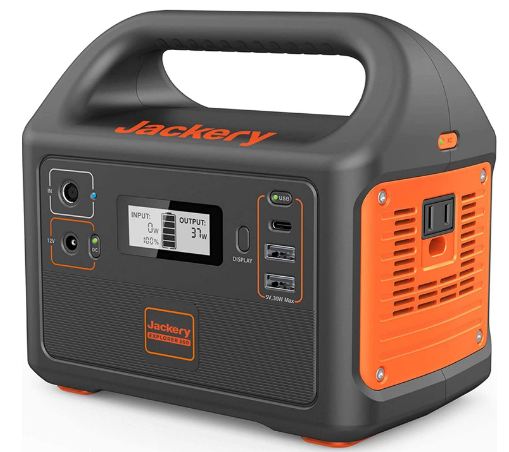
If your outdoor adventures usually don't involve walking long distances, I have a better idea for you. Instead of these small solar phone chargers, get a portable power station.
A power station is like a big power bank. It has a bigger battery and more outlets, including multiple USB, DC and AC outlets.
Most solar power stations (also called solar generators) can charge devices like smartphones and tablets, and power small appliances like a car fridge or CPAP.
One of the lightest solar generators is the Jackery Explorer 160. It has a 167 watt-hour lithium battery (46,400 mAh) and can produce up to 100W of AC power.
The Explorer 160 has three USB ports to charge your devices: a USB-C port and two USB-A ports. There’s also one AC outlet and a 12V car outlet.
There are three ways to recharge the Explorer 160. You can plug it into a wall outlet with the included AC charger, charge it from our car’s cigarette lighter socket with the included car charger, or connect it to a 60W solar panel.
The Jackery 160 weighs almost 4 lbs. It’s probably a bit too heavy for hiking and backpacking, but it’s perfect for camping, fishing, road trips and other outdoor activities. You can also use it at home to provide backup power for your devices and small appliances in an emergency.
There are plenty of other lightweight power stations that are great for outdoors. Some of my favorite include the Bluetti EB3A (16.5lbs, 268Wh capacity, 600W output), Renogy Phoenix 200 G2 (5.2lbs, 222Wh capacity, 200W output), and this compact 84Wh Eco-Worthy power station complete with an 18W solar panel.
Care & Maintenance
The Patriot Power Cell doesn't need much in terms of maintenance. Just keep the power bank safe and protected from the elements and extreme temperatures.
While it is water resistant, it’s not a good idea to leave it in the rain or snow. An occasional wipe down is also recommended to keep the solar charger clean and dust-free.
When you store the Patriot Power Cell, make sure it’s in a cool and dry place. If you can, place it inside a pouch or box away from where it can encounter dust, debris or moisture.
Charge the power bank to about 80% before storage. Then once a month, recharge it again to keep the battery from completely discharging.
Warranty
4Patriots offers two guarantees on the Patriot Power Cell.
They have a 1-year free return guarantee on all their products, though this may not apply to products bought on other websites like Amazon.
Secondly, the Patriot Power Cell comes with a 2-year warranty.
Specifications | |
|---|---|
Capacity: | 8,000 mAh |
Battery: | Lithium-polymer |
Lifespan: | About 500 life cycles (3-5 years) |
Weight: | 6.8 ounces |
Size: | 5.4” x 2.9” x .74” |
Final Thoughts: Should You Buy The Patriot Power Cell?
If you are shopping for an ultra-light solar charging power bank, then the Patriot Power Cell is a good pick. Just keep in mind that the solar charging function is not very useful.
It’s also a great pick if you just want a small (less than 10000 mAh) power bank for short hikes, day trips and emergencies.
But if you want a high-capacity solar charging power bank or a solar charger that actually charges with solar, then I recommend looking at the alternatives I have reviewed above.
The Patriot Power Cell is also not the best bargain you can find. So shop around a bit more to see if you can get a better price.
For instance, Blavor has a 10,000 mAh solar power bank (with the same gimmicky built-in solar panel) for slightly less than the cost of the Patriot Power Cell. The Blavor power bank has a USB-C port and a wireless charging pad.
Where To Buy?
You can get the Patriot Power Cell on the official 4Patriots website. It’s also available on Amazon.

